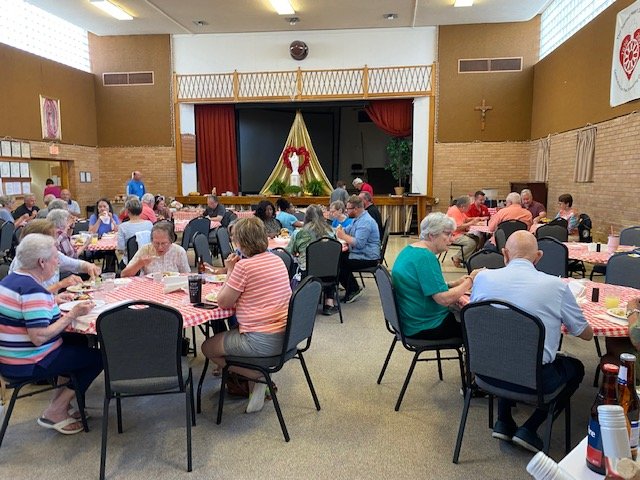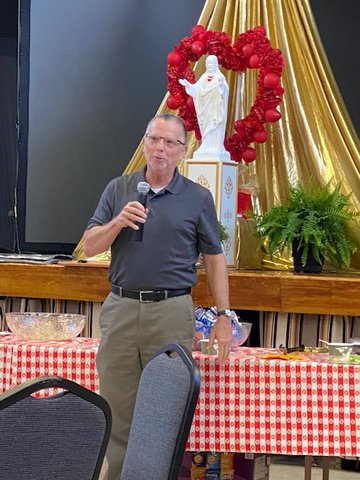Columbia Sacred Heart parishioners discuss: “Was Jesus homeless?” “What does He want us to do?”

Tom Turner’s brother had been helping a man in need for years.
Mr. Turner once offered to step up and relieve him.
“He’s MY Lazarus! You go find your own!” the brother fired back, referring to Jesus’s parable of the rich man and the beggar (Luke 16:19-31).
Mr. Turner shared that story during two informal “Eat and Learn” gatherings in the Sacred Heart Parish Activity Center in Columbia.
“We’ve all got to find our own Lazarus,” he told the people at both events, which were sponsored by Sacred Heart Parish.
The topic — “Was Jesus homeless?” — was based on Jesus’s statement, “The Son of Man does not have a place where He may lay His head” (Matthew 8:20), and “I was homeless and you took Me in” (Matthew 25:35).
Forty-two people shared a Sunday evening dinner prepared by members of the parish’s Faith Formation Commission, their spouses and friends.
A smaller gathering shared breakfast, also prepared by parishioners, the following morning.
The people at each table then entered into small group discussions facilitated by Mr. Turner, retired executive director and administrator of the Bishop Sullivan Center (bishopsullivan.org) in Kansas City.
Named for the late Bishop John J. Sullivan of Kansas City-St. Joseph, the center offers various forms of help to people in need while facilitating personal relationships between people who are homeless and the rest of the community.
Mr. Turner is a former classmate of Monsignor Gregory L. Higley, pastor of Sacred Heart Parish.
He now works for Morning Glory Ministries, an outreach of Cathedral of the Immaculate Conception Parish in Kansas City, serving breakfast to people who are homeless.
“When we encounter some big social issues — things like homelessness, poverty, immigration, racism — it can be easy to say, ‘This is too big. I can’t do anything about this,’ and back off,” said Mr. Turner.
Yet, Jesus was always challenging His Apostles to do whatever they could.
“Even if it’s just a couple of loaves and fishes, present that and He’ll do the rest,” said Mr. Turner.
Four-part discussion
Mr. Turner engaged the people in four rounds of discussions about homelessness in Columbia, based on the “Pastoral Circle” method articulated by Joe Holland and Peter Henriot in their book, Social Analysis: Linking Faith and Justice.
“It’s a process to help people of faith engage the bigger social issues,” said Mr. Turner.
He first asked people to talk about their personal experience of homelessness: “Have you seen someone up close? Do you know someone personally?”
He then asked them to talk about the causes they see for chronic homelessness in their community.
He then challenged them to think about what their faith has to say about the issue, and finally, to discuss what that means they’re supposed to do.
As an example, Mr. Turner recalled a fifth-grade teacher who was volunteering at Morning Glory Ministries one day, helping to feed about 125 people who had nowhere else to go.
She looked out over the crowd and remarked: “They were all fifth-graders once, just like my students. What happened to them? How did they get from there to here?”
“I thought that was a really empathetic question on her part,” said Mr. Turner. “We all come from someplace.”
Interlocking causes
In the small group discussions, people spoke with animated voices and gestures, sharing their own interactions with people who are homeless.
Several participants are current or previous members of the St. Francis Catholic Worker Community in Columbia.
One participant talked about an acquaintance who was so poor, he wound up having his children taken away from him.
Another spoke of an incredibly intelligent relative of a university professor who simply preferred to live outside.
One spoke of giving strangers rides where they need to go but not giving them money.
Causes and solutions were deemed complex and elusive.
“We came to the conclusion that when you’re born poor, it’s not easy to work your way out of that,” one participant stated. “You have to have help. And sometimes, even if you have that help, you still don’t make it.
“You might have food or clothes if you have a job, but maybe not a place to live,” the participant added.
One person noted how some people fall victim to predatory lending or financing schemes and wind up losing everything they own.
Another mentioned how past generations tended to look out for their neighbors better than people do today.
Another talked about how newer approaches to mental health led to the abrupt closing or scaling-back of many mental hospitals throughout the country.
“We moved people back into the communities but didn’t develop resources to help them out there,” she said.
“What should I do?”
People talked about the clarity of Biblical teaching on helping people in need.
However, they noted, there are many ways to do that, and figuring out the best way can be difficult.
“The bottom line for me: it’s very complicated,” said one participant. “A lot of time, there’s so much more than meets the eye.”
Mr. Turner emphasized that the answer to “What should I do?” is personal and should be based on the responsibilities that come with each individual’s stage in life.
“Depending on your situation, your life, your time commitments, maybe for some, the most you can do is come to a presentation like this and listen,” he stated.
“Others can volunteer,” he said. “Others do personal things for a homeless person who has crossed their path. Others maybe get more engaged at a political level.
“It’s definitely not one-size-fits-all,” he stated. “You enter that issue in terms of what fits for you. And that could change over time.”
He emphasized, however, that everyone needs to be doing something to help people who are chronically in need.
“If you’re concerned about giving money directly to someone you meet on the street, you can still be a Good Samaritan by giving a donation to an organization — a ‘good innkeeper’ — that’s doing a good job helping the homeless population,” he said.
“Eye-opening”
Sacred Heart parishioner Mary Kay Head said the gathering was instructive and enjoyable.
She noted that the downtown Columbia churches do a lot to help people who are homeless, “and I am really proud of that.”
“But this meeting and these discussions made me feel like I shouldn’t just sit back and think, ‘Okay, we’re doing our share,’” she said. “There’s so much more we can do, and this kind of opened my eyes to that.”
Mr. Turner said he was impressed by the number of people who attended the discussions, along with their level of engagement.
“It was good to see so many people who are interested in this issue and the general concern for people who are homeless,” he said.
He was also impressed to learn how well various churches in Columbia work together to help people who are homeless in ways that no single congregation could do alone.
Msgr. Higley said he believes the discussions were good for his parishioners, especially as Columbia weighs options for providing more help to people are homeless, such as opening a year-round shelter.
“We still have a lot more to learn and think and pray about,” he said.
Comments
Other items that may interest you
Services
The Catholic
Missourian
2207 W. Main St.
Jefferson City MO 65109-0914
(573) 635-9127
editor@diojeffcity.org







